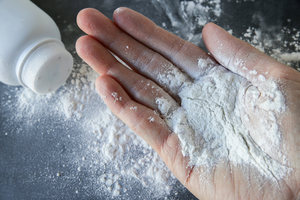
Here in hot North Carolina, baby powder can feel like a necessity. But just for adults, please, unless it’s made with something other than talc! Baby powder containing talc bears a warning label to keep it out of the reach of children. Many pediatricians discourage its use with babies, because if they inhale the particles they can become seriously ill and in extreme cases, die. There are many baby powders made with cornstarch, but Johnson & Johnson continues to use talc, and continues to market the powder as safe.
Even for adults, there is good reason to fight chafing with something other than talcum powder. This past April, we reported on our blog that a Missouri jury awarded $72 million to the estate of a woman who had died of ovarian cancer at the age of 62, after she used talc in the area of her genitals for her entire life. That is a pretty big number, so we thought we would follow up to see what may have gotten the jurors so riled up.
When you put twelve jurors in a box in a civil case they tend to take their jobs seriously. From what I have seen, especially after it has taken several days to seat them, jurors try hard to listen to both sides before making up their minds. They keep poker faces and don’t let the lawyers see what they are thinking. A verdict in the high millions usually means that the jurors were fed up with the defense.
In a recent article in Trial magazine, author Diane M. Zhang tells us more about why the jury in the case of Fox v. Johnson & Johnson decided to give so much money to one family. It’s because, for example, they heard that talc was first classified as a carcinogen by the United States National Toxicology Program in 1993. In 1994 the Cancer Prevention Coalition asked the J&J CEO to withdraw its talc products from the market, but as we know the company did not.
The jury heard that two years before the request, in an internal memo the company noted, “[n]egative publicity from the health community on talc (inhalation, dust, negative doctor endorsement, cancer linkage) continues.” Yet the company made plans, according to the New York Times, to “grow the franchise” by targeting African Americans and Hispanics. In 1996, condom manufacturers stopped using talc in their products
In 2006, J&J’s main supplier of talc began to issue a warning with its product, which J&J did not pass on to its consumers. Also, the jurors heard that J&J executives discussed how to influence regulators, hire experts who would see things their way, and keep information about the dangers of talc away from the public.
The US Food and Drug Administration has not banned the use of talc, stating that there is “no conclusive evidence” that using talc causes ovarian cancer. However, the majority of studies have shown that women who regularly use talcum powder have an increased risk of developing this dreaded disease. This likely influenced the jury a great deal.
So what is the final takeaway? If your doctor hasn’t prescribed talc-based baby powder for you as a medical necessity, why use it? Ovarian cancer is often fatal. There are powders made with cornstarch that are very effective. But here are some other places where you might find talc, which may surprise you. It’s in chewing gum, medicine tablets and some rice.
So, read the labels, and remember, just because a product is advertised as just right for a baby, it may not be.
 Call Us 919-240-4054
Call Us 919-240-4054